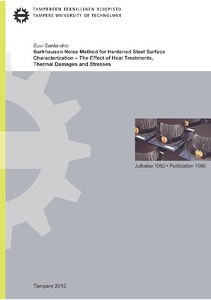Barkhausen Noise Method for Hardened Steel Surface Characterization - The Effect of Heat Treatments, Thermal Damages and Stresses
Santa-aho, Suvi (2012)
Santa-aho, Suvi
Tampere University of Technology
2012
Automaatio-, kone- ja materiaalitekniikan tiedekunta - Faculty of Automation, Mechanical and Materials Engineering
This publication is copyrighted. You may download, display and print it for Your own personal use. Commercial use is prohibited.
Julkaisun pysyvä osoite on
https://urn.fi/URN:ISBN:978-952-15-2947-4
https://urn.fi/URN:ISBN:978-952-15-2947-4
Tiivistelmä
This work concentrates on the non-destructive magnetic Barkhausen noise (BN) method. The BN method can be utilized in the detection of altered material properties such as changes in microstructure and stress. Method can be used e.g. in detection of grinding burns from hardened and ground gears. One challenge in the BN utilization is the lack of standardized quantification processes and varying guidelines for the use of the method.
One of the aims of this study was to manufacture calibration samples for BN device to be used in quality control. The calibration samples must be characterized properly (microstructure, residual stress, surface condition) in order to use them. Then, the calibration samples can be used directly to verify the readings of the measurement device. In addition, these samples allow a more thorough analysis of the BN signal. The verification of the Barkhausen noise readings will give more confidence to the quality control. Two possible methods, induction heating and laser processing were studied for creation of controlled thermal damages. Laser processing was found to be more suitable method for producing these controlled thermal damages.
One of the current topics of BN method development is its application to case-depth measurements of hardened components. The non-destructive detection of hardened layer thickness would be useful in detection of layer left for re-grinding and verification of case-depths of hardening heat treatments. This study presents also results of the utilization of commercial Rollscan equipment to case-depth analysis. Method presented here is based on magnetizing voltage sweeps generated from the hardened samples. Calculated slope from magnetizing voltage sweep and division of these measured slopes using varying frequencies can give information about the sample with composition gradients and microstructure gradients related to case-depth value.
The relation between BN and stress is not yet well understood. This study also concentrates on this part of BN phenomenon. Here elastic stress was applied to case-hardened steel samples to examine the effect of elastic stress to BN responses. The stress sensitivity was found to be different in test bars with different hardness values obtained with tempering. The results revealed a linear behaviour of the reciprocal RMS value as a function of the applied stress. The stress sensitivity of the RMS value was noticed to depend on the surface hardness of the specimen.
One of the aims of this study was to manufacture calibration samples for BN device to be used in quality control. The calibration samples must be characterized properly (microstructure, residual stress, surface condition) in order to use them. Then, the calibration samples can be used directly to verify the readings of the measurement device. In addition, these samples allow a more thorough analysis of the BN signal. The verification of the Barkhausen noise readings will give more confidence to the quality control. Two possible methods, induction heating and laser processing were studied for creation of controlled thermal damages. Laser processing was found to be more suitable method for producing these controlled thermal damages.
One of the current topics of BN method development is its application to case-depth measurements of hardened components. The non-destructive detection of hardened layer thickness would be useful in detection of layer left for re-grinding and verification of case-depths of hardening heat treatments. This study presents also results of the utilization of commercial Rollscan equipment to case-depth analysis. Method presented here is based on magnetizing voltage sweeps generated from the hardened samples. Calculated slope from magnetizing voltage sweep and division of these measured slopes using varying frequencies can give information about the sample with composition gradients and microstructure gradients related to case-depth value.
The relation between BN and stress is not yet well understood. This study also concentrates on this part of BN phenomenon. Here elastic stress was applied to case-hardened steel samples to examine the effect of elastic stress to BN responses. The stress sensitivity was found to be different in test bars with different hardness values obtained with tempering. The results revealed a linear behaviour of the reciprocal RMS value as a function of the applied stress. The stress sensitivity of the RMS value was noticed to depend on the surface hardness of the specimen.
Kokoelmat
- Väitöskirjat [4773]
